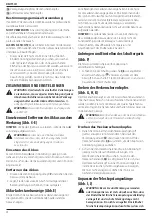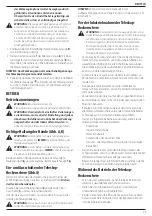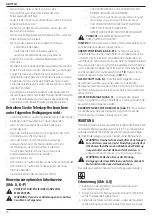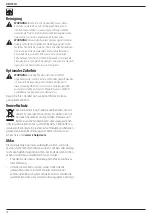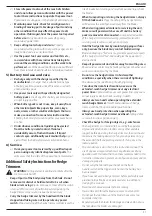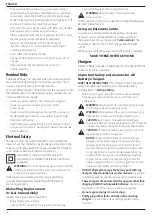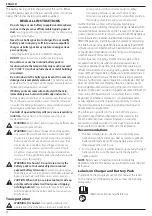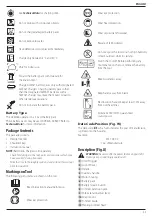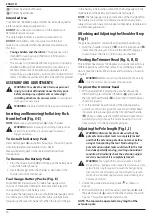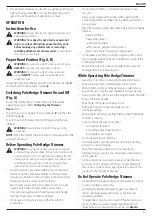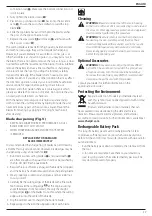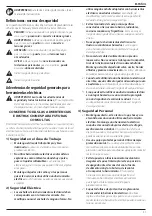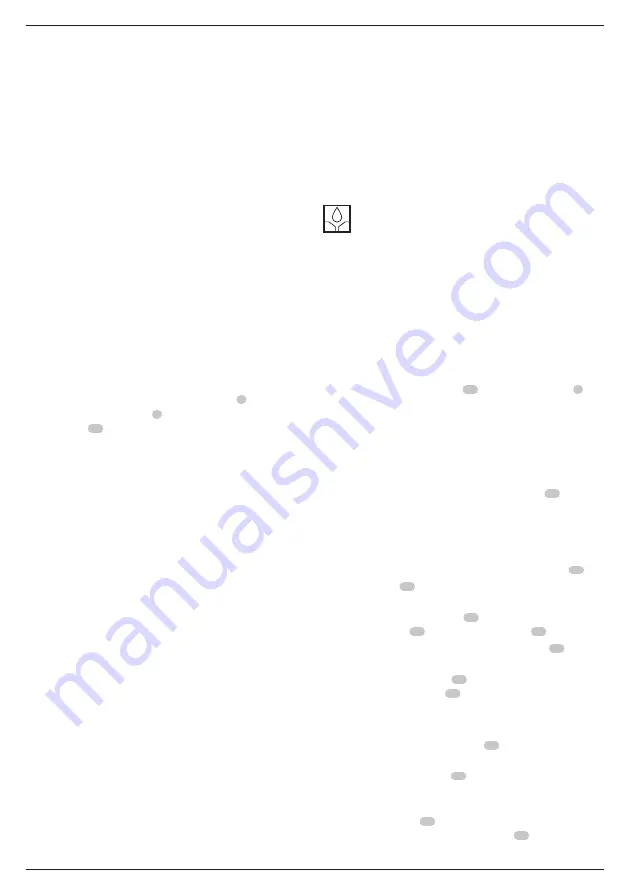
38
EnGLIsH
• while in a hurry
• while in tree or on a ladder
• while on aerial booms, buckets or platforms
• during high wind or storming weather
Trimming Instructions (Fig. A, K–P)
DANGER:
KEEP HANDS AWAY FROM BLADES.
WARNING: To guard against injury, observe the
following:
• READ INSTRUCTION MANUAL BEFORE USING. SAVE
INSTRUCTION MANUAL.
• Check the hedge for foreign objects such as wires or
fences before each use.
• KEEP HANDS ON HANDLES. DON’T OVERREACH.
• DO NOT USE UNDER WET CONDITIONS.
CAUTION:
BLADE MAY COAST AFTER TURN OFF.
nOTE:
Jamming the blade on large branches can
cause damage.
WORkInG POsITIOns (Fig. k–M)
– Maintain proper footing
and balance and do not overreach. Wear safety goggles, non-
skid footwear when trimming. Hold the unit firmly in both
hands and turn the unit on. Always hold the trimmer as shown
in Figure K, with one hand on the switch handle
3
and one
hand on the auxiliary handle
4
. Never hold the unit by the
trimmer head
12
.
TRIMMInG nEW GROWTH (Fig. n)
– Using a wide, sweeping
motion, feeding the blade teeth through the twigs, is most
effective. A slight downward tilt of the blade in the direction of
motion gives the best cutting.
LEVEL HEDGEs (Fig. O)
– To obtain exceptionally level hedges
a piece of string can be stretched along the length of the hedge
as a guide.
sIDE TRIMMInG HEDGEs (Fig. P)
– Orient the trimmer as
shown and begin at the bottom and sweep up.
Guidelines for trimming (UK & Ireland)
• Trim hedges and shrubs with seasonal leaves (new leaves
every year) in June and October.
• Trim evergreens in April and August.
• Trim conifers and other fast growing shrubs every six weeks
from May until October.
Guidelines for trimming (Australia & New
Zealand)
• Trim hedges and shrubs with seasonal leaves (new leaves
every year) in December and March.
• Trim evergreens in September and February.
• Trim conifers and other fast growing shrubs every six weeks
from October until March.
MAINTENANCE
Your
D
e
WALT
power tool has been designed to operate
over a long period of time with a minimum of maintenance.
Continuous satisfactory operation depends upon proper tool
care and regular cleaning.
WARNING: To reduce the risk of serious personal
injury, turn tool off and disconnect battery pack
before making any adjustments or removing/
installing attachments or accessories.
An accidental
start-up can cause injury.
WARNING: Remove battery pack before servicing,
cleaning or removing material from the
hedge trimmer.
The charger and battery pack are not serviceable.
Lubrication (Fig. A, Q)
1. After use, carefully clean the blades with a resin solvent.
2. After cleaning, apply a light film of lubrication to the
exposed blade.
3. Turn the trimmer vertical with the blades toward the ground
and run the trimmer for a few seconds to fully disperse
the lubrication.
Gear Housing
1. With a grease gun, apply a good quality lithium based
grease via the grease fitting
16
. on the gear housing
5
.
nOTE:
Additional grease should be applied at 40 hour intervals
or more frequently with heavy usage.
Replacing Blade (Fig. R, S, T, U)
WARNING:
Sharp edges. Wear gloves when performing
any maintenance on the trimmer blade.
Follow the instructions below to replace the blade
11
or bring
the trimmer to a
D
e
WALT
factory service centre, a
D
e
WALT
authorised service centre, or other qualified service personnel.
Always use identical replacement parts.
1. Remove battery.
2. Using a 4 mm hex bit, remove the four cover screws
17
.
3. Pry the cover
18
off by placing a flathead screwdriver under
the back of the cover and twisting.
4. Remove the thin wear plate
19
. Remove the top
connection rod
20
from the eccentric cam
21
.
5. Using a 4 mm hex bit, remove the blade screws
22
and washers.
6. Lift the front of the blade
11
to disengage it from the
bottom connection rod
23
and pull the blade out of
the trimmer.
Installing Blade
1. Install blade screws and washers
22
from the old blade into
the hole in the new blade.
2. Line up the blade screws
22
on the new blade with their
respective slots in the hedge trimmer head.
3. Mostly tighten the blade screws. Do not tighten fully. Slide
the bottom blade
24
back and forth, and press down
slightly until the blade catches the post
25
on the bottom
Summary of Contents for Pro Landscaping DCM586
Page 1: ...DCM586 ...
Page 3: ...1 Fig A Fig B Fig C Fig D 6 6 7 11 9 8 7 5 6 4 2 1 3 10 12 13 14 7 ...
Page 4: ...2 13 14 Fig F Fig H Fig E Fig G Fig I Fig J Fig L Fig K 10 15 9 8 4 ...
Page 5: ...3 Fig N Fig O Fig P Fig Q Fig R 16 Fig S Fig T 17 18 19 21 20 22 11 25 24 23 26 Fig M ...
Page 6: ...4 Fig V Fig U Fig W 27 29 30 28 31 ...
Page 161: ...159 ...
Page 162: ...160 ...
Page 163: ...161 ...

